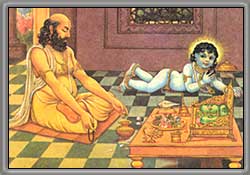
VIGRAHA III. (Image).

1) General information. God, who is not discernible to the outward senses, is given embodiment and consecrated in places of worship by people. These figures are called Vigrahas (idols or images). People worship Salagrama, (a kind of ammonite found in the river Gandaki), Banalinga (Phallus), mystical diagrams, animals, birds, trees, rivers, lakes, places of death etc. and so many other things.
2) The different kinds of vigrahas. Vigrahas are of three groups. They are :-(1) Mysterious (2) Evident-mysterious (3) Evident. Salagrama, Phallus etc. belong to the group mysterious. The Mukhalinga, considered to be the image of Trimurti (Brahma, Visnu, Siva) in the Elephanta cave, belongs to the group Evident. The image of Phallus is Evident-mysterious. In the first, there is no form or figure. In the second there are parts of the figure. The image which shows the entire figure is Evident.
Some gods and goddesses possess two appearances peaceful and fierce. Those who wish to succeed in performing cruel deeds and to vanquish enemies, worship fierce gods whereas those who wish for peace, worship peaceful Gods. Visvarupa, (assuming all shapes), Narasimha (the man-lion), Vatapatragayi (as lying on banyan-leaf) and Parasurama are fierce forms of Visnu. Destroying Kama (cupid) Gaja and Tripura are fierce forms of Siva worshipped by some people. Generally temples with images in this form are erected outside the village or city.
Owing to the differences, in the making and the materials used, the images are divided into three groups They are portraits, Half-portraits and corrupted portraits. The whole of the figure will be made in (portraits) citras. In half-citras only the front view will be completed. Corrupted Citras are images done on the wall or rock.
3) Main images. Main images are mostly Saivite or Vaishnavite. There will be one or two other images. Worship of Devi (Goddess) is one of them. The Saivites will worship Parvati also after Siva and the Vaishnavite Mahalaksmi also after Visnu In South India the worshippers are Saivites and Vaishnavite.
4) Saivites. In India a large number of people worship Siva. There is not much difference in the mode of worship of these various people. There are worships which are in accordance with the Vedas and which are not. Forms of worship which are Sattvika (of goodness) and which are not, could be seen. The Saiva worship called Prabhupada is very ancient. The phallus at Gudimalla is considered to be as old as B.C. 2nd century. From this it could be inferred how old, the Saivite worship is in India.
5) The Saivite images. Of the emblems denoting Siva, the most important is the Phallus, which is of two kinds, movable and immovable. Risen by itself and/or erected and set firm and consecrated inside temples are immovable; that which is made of earth, metal, jewel, wood or stone, is movable. There are Phalluses made for the time being. They are fixed on platforms or pedestals. They are of different sizes and shapes. The Phallus is made of male stone and the pedestal of female stone.
6) The portions of Siva. There are various kinds of images meant to reveal various attributes of Siva. Lingodbhava (originated from Phallus), Candrasekhara, Raudra, Umasamhita (with Uma) etc. are some of them. Kamantaka (killing Kama or Cupid), Gajari (enemy of Gaja), Kalari (Enemy of Yama) and Tripuradahaka (burning Tripura) are figures of extermination. Siva has the figures of blessing Candesa, Visnu, Nandisvara, Vighnesa and Arjuna also. There are a large number of images in various dancing poses.
There are four other figures of Daksinamurti, such as the explanation, knowledge, yoga (or meditation, contemplation and other ways of union with the Universal Soul) and Vinadhara (carrying a lute). A few other forms are Bhiksataka (begging alms), Kapaladhari (wearing skulls), Gangadhara (bearing the Ganges), Ardhanaris vara (God half of whom is a woman), Vrsabhavahana (seated on a bull), Visabhaksaka (eating poison) etc. The figures of Sadaisiva, Mahega, Ekadaarudras (eleven Rudras), Vidyesvara and Murtyastaka are seen occasionally here and there. There are scriptures describing these figures.
7) The Devas (gods) connected with Siva. Among the gods connected with Siva, first place is given to Ganapati. Worship of Ganapati was in vogue from 6th or 7th century B.C. Perhaps the images that we see today were made after this period.
In South India temples dedicated to Ganapati are not scarce. The Position of Ganapati is at the entrance of villages and fortresses, at the foot of banyan trees, at the entrance of temples and at the south-west corner of Saivite temples.
There are images of Ganapati in the postures of standing and dancing. Main images are those with the trunk turned to the right and to the left. The trunk is turned to the right in some and to the left in others.
8) Subrahmanya. Subrahmanya is worshipped only in South India. Subrahmanya is known by various names such as Kumara, Muruka, Karttikeya, Skanda, Arumukha, Guha, and so on. Temples dedicated to Subrahmanya are seen in plenty in Tamil Nadu. They are all situated on the tops of hills.
There is sufficient proof in the poetic works of the Sangha period, to the fact that Subrahmanya-worship was prevalent in South India. On excavation at the place Nagarjunakonda in the District of Guntur, images of Subrahmanya were found under the earth. They were as old as 3rd century B.C.
Images of Subrahmanya are seen in various postures and shapes such as sitting, with six faces, with one face, with two hands, with four hands, sometimes with wife, in the state of having finished investiture with the Brahma-string etc. There are figures sitting on the peacock also.
9) Other images. Images of Sakti, Laksmi, Earth-goddess, Sarasvati, Saptamatrs (Seven Mothers), Jyestha, Visnu, the ten incarnations, the planets such as the sun etc. the deities of the weapon like the thunderbolt, Sakti (lance), Nandikeshvara, Candesvara, Masta, Ksetrapala, Brahma, Guardians of the zones, Asvinidevas, half gods, etc. are also dedicated and worshipped in temples.
(Puranic Encyclopedia CDRom)




